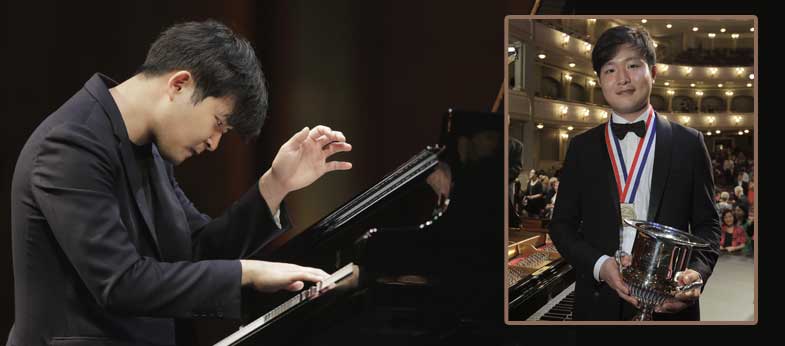
About
Gold Medalist of the 15th (2017) Van Cliburn International Piano Competition , 28-year-old pianist Yekwon Sunwoo has been hailed for “his total command over the instrument and its expressiveness” (San Francisco Examiner). A powerful and virtuosic performer, he also, in his own words, “strives to reach for the truth and pure beauty in music.”
Born in Anyang, South Korea, Mr. Sunwoo began studying piano at age 8. He gave recital and orchestra debuts in 2004 in Seoul before moving to the United States to study with Seymour Lipkin at the Curtis Institute of Music. He earned his bachelor’s degree there, his master’s at The Juilliard School, and his artist diploma at the Mannes School of Music.
In addition to the Cliburn Gold Medal, Mr. Sunwoo won first prizes at the 2015 International German Piano Award, the 2014 Verbier Festival’s Vendome Prize, the 2013 Sendai International Music Competition, and the 2012 William Kapell International Piano Competition. He is also an avid chamber musician.
Mr. Sunwoo’s 2017–2018 season continues his solo performances in prestigious venues and with renowned orchestras in the United States, Europe and Asia.
Program
Program Notes
Franz Schubert revered Beethoven, and many believe Schubert was spurred to write his last three sonatas, months before his death, by Beethoven’s death in 1827. The Sonata in C minor was the first and bears many similarities to Beethoven’s works, including the C minor key signature, which is notably used in Beethoven’s Symphony No. 5 and Piano Sonata Op. 13 “Pathetique.” The Allegro movement starts the piece with restlessness, much as Beethoven would. There is little opportunity to find a resolution; tranquil moments are filled with sadness and uncertainty. In the third movement’s A section, Schubert inserts silent pauses every few bars to add even more mystery. Where Beethoven would have written a cadenza leading to a triumphant finish, Schubert’s Sonata ending is marked by a low tremor before two abrupt chords.
Another work born out of respect for a fellow composer, Percy Grainger’s “Ramble,” based on Richard Strauss’ 1911 comic opera Der Rosenkavalier, is a great work that transposes operatic moments onto the piano. The opera tells the story of a young Count who falls in love with a bride-to-be as he is delivering an engagement rose on behalf of her fiancée, as his “Rosenkavalier.” Grainger includes many detailed performance instructions and makes liberal use of the middle (sostenuto, sustain) pedal. The result is a love-duet augmented with unique harmonies and flourishes.
Sergei Rachmaninoff composed his Piano Sonata No. 2 Op. 36 in 1913 and in 1931 revised it by removing superfluous sections. This is the version usually performed today. Although in sonata form, the work flows like a single, coherent piece, with bridges between the movements. The first theme begins with a bold arpeggio down the keys; a cadenza-like passage ultimately leads to a chorale-like second theme. In section after section, the melodies undergo dramatic change but without a clear break or transition. The second movement, Non allegro-Lento, references first movement themes, but takes on a very different form and feel. The tempo slows, creating moments of clarity. Only then does the piece move into the final movement, which repeats the the second movement interlude, intermingles new themes with those of the first movement, and concludes with a brilliant coda.
Maurice Ravel composed La Valse for orchestra in 1919-1920 and later transcribed it for piano. Because of its difficulty, the transcription is infrequently performed. The composer had planned a tribute to waltzing Vienna and Johann Strauss, but after the horrors of WWI he composed instead a terrifying tone poem, a bitter and ferocious fantasy. The piece opens with light rumbles, as fragments of melodies are heard; gradually more voices join in and the atmosphere brightens. In the second half, each of the melodies return with tempo changes, modulations and new intonations. A tumultuous danse macabre (dance of death) coda ends in a final measure, perhaps symbolically, not in waltz-time.